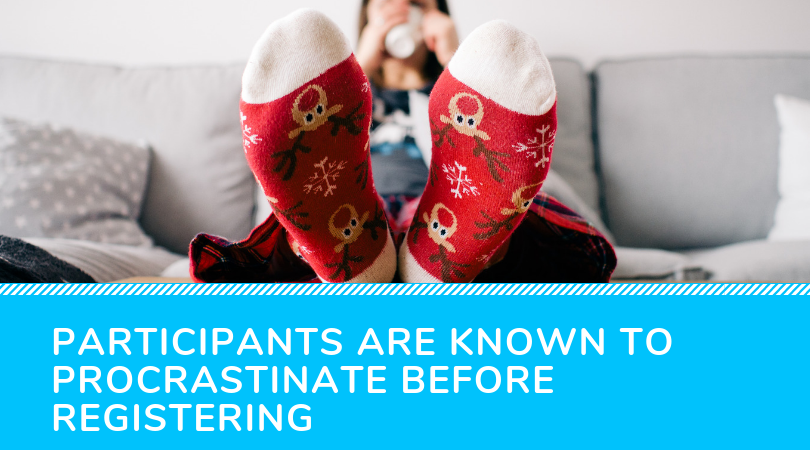Participants are known to procrastinate when it comes to sealing the deal on your event. Just look at how many last-minute abstract submissions you receive every year! It’s no surprise that the same pattern repeats itself when it comes to registration. When as many as 97% of your website first-time visitors leave without signing up or completing a ticket purchase, you need to have other strategies in place to make sure your event stays top of mind. That’s where retargeting for events comes in.
Originally used by online retailers and merchandise sales, retargeting is becoming an increasingly common practice among event marketers. The marketing rule of 7 states that a prospect needs to hear about your offer 7 times before they pull the trigger on your call-to-action.
What is event retargeting?
Retargeting is a form of online advertising that allows you to target past anonymous website visitors and re-display your marketing offer to them. When a potential attendee visits your website, they get tagged through a pixel and a cookie is set in their browser. The browser cookie (not a cookie of the Oreo variety) is then used to trigger ads to appear as the person browses other websites. The entire process is unobtrusive and seamless.
Another option is list-based retargeting, which allows you to upload your entire member email list or past attendee lists onto the advertising platform, and specifically target these people as part of your advertising campaign. Because an existing customer is much easier to sell to than a new one, combining email and retargeting ads creates a powerful mix.
Check out 5 ways that retargeting can seriously boost registrations:
1. Recapture registration abandonment
Most prospective attendees will not register on their first visit, essentially abandoning their “shopping cart”. A cart abandonment campaign is a tried-and-tested method for generating conversions, regardless if your event is free to attend or not.
You know these prospects have shown an interest in your event because they have visited your event landing page. The reason why they didn’t register right away is not immediately important; after all, everyone needs a little reminder sometimes. What’s crucial is to not let this valuable segment slip away.
With retargeting you could deliver ads to everyone who visited the registration page but didn’t complete it, and remind them to do so. You can also combine this with your event timeline, and create distinct ads announcing registration opening, speaker reveals, early-bird discounts or last-chance registrations. According to recent statistics, up to 60% of respondents say retargeting would encourage them to make a purchase they initially abandoned.
2. Find new attendees based on past attendance
Once you have created your retargeting audiences, whether pixel-based or list-based, you can create what are called “lookalike audiences” on platforms like Facebook. A lookalike audience lets you reach new prospects who might be interested in your event because they are similar to your past attendees.
A lookalike audience is an audience that is similar to your source audience. For example, let’s say you uploaded your email list onto Facebook and are ready to run a retargeting campaign. Facebook will examine everyone on your list and try to identify their online behavior, patterns, and interests. It will look for new people who share those very same markers in order to create the lookalike audience.
This can be incredibly useful, not only to help you keep acquisition costs low but also to scale up your potential audience size. It’s almost like doubling your entire email list all at once.
3. Retargeting can help prevent event no-shows
No-shows are a real thorn in the side of many meeting planners. Some report no-show rates of as much as 50% for free events, while the no-show rate for paid events hovers at around 10%.
Retargeting allows you to re-engage your registrants and get them to make further micro-commitments, in turn reducing no-shows. These campaigns can come in the form of accommodation discounts, app downloads or even 1:1 meetings with speakers and exhibitors. Anything you can do to add perceived value contributes to increased commitment. Give your event a “personal price tag” through such commitments.
4. Better event marketing ROI
Instead of letting your potential attendees slip through the cracks, event retargeting gives you a second chance to appeal to them wherever they are online. Whether they are on Facebook, Twitter, LinkedIn, Google, or reading a news article, you’ll be there to nudging them to give your event another look.
Retargeting has significant benefits for your brand awareness, but most importantly it will give you a better return on your paid social media ad dollars. That’s because by targeting people who have previously shown interest in your event, they are more likely to convert, hence lowering your acquisition costs and increasing your event registration. A well-executed event retargeting campaign can deliver exceptional ROI.
5. Increase registrations using snöball’s retargeting campaigns
Imagine combining influencer marketing, a powerful tactic for expanding your event’s reach, with retargeting, a proven technique for selling out your event.
Your event marketing strategist will analyze your event influencer marketing campaign results in real-time and help you grow even further through landing page retargeting along with other initiatives. See how snöball event influencer marketing can supercharge your event!


